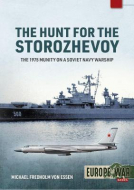
- Agriculture
- Architecture & Design
- Arts & Photography
- Biography
- Business
- Calendars and Diaries
- Childrens (All)
- Childrens (Illustrated)
- Childrens (Picture flats)
- Childrens (Te Reo)
- Classics
- Cooking, Food & Drink
- Craft & Hobbies
- Design (Art / Graphics)
- Design (Interiors)
- Education
- Fashion
- Fiction & Literature
- Fiction - Young Adult
- Gift Ideas
- Health & Wellbeing
- History
- Home & Garden
- Humour & Gift
- Instead of a Card Poems
- Military
- Music
- New Zealand
- NZ (History)
- NZ (Landscapes)
- NZ (Pictorial)
- Poetry
- Reference
- Religion & Faith
- Science & Nature
- Sport & Recreation
- Stationery
- Taschen : 40th Anniversary Edition
- Taschen : BA Basic Art
- Taschen : BU Bibliotheca Universalis
- Te Reo Māori
- Transport
- Travel
Michael Fredholm Von Essen (3)
|
The Hunt For The Storozhevoy
ISBN: 9781915070708 Author: Michael Fredholm Von Essen Publisher: Helion & Company In 1975, Lieutenant Commander Valeriy Sablin led his crew in a mutiny on the Soviet warship Storozhevoy. The ship was then located in Riga, Soviet Latvia. Sabli... In 1975, Lieutenant Commander Valeriy Sablin led his crew in a mutiny on the Soviet warship Storozhevoy. The ship was then located in Riga, Soviet Latvia. Sablin's avowed intention was to foment a new communist revolution by taking the warship to Leningrad, where he expected to receive the support of the navy and the masses. However, the Soviet leadership thought that Sablin intended to defect to Sweden, bringing with him a warship of modern design with all its armaments, electronics, communication devices, and code books. As a result, Soviet supreme leader Leonid Brezhnev ordered the destruction of the warship. After several dramatic, but ultimately failed, attacks on the Storozhevoy, Colonel General Sergey Gulyayev, commander of the Naval Aviation of the Baltic Fleet, personally ordered a missile launch against the Storozhevoy, employing the special protocol for the launch of nuclear missiles. The purpose of the launch was to destroy the warship. However, by then the crew had already detained Sablin and announced their intention to surrender. The air crews did not know this; however, their commanding officer, Colonel Arkhip Savinkov, never launched the missile, instead faking a radar malfunction. The mutiny was over. Due to the very serious implications of the suppressed mutiny, and the difficulties in finding and attacking the Storozhevoy, which showed that the combat readiness of the Soviet armed forces was less than desired, the participating air crews were ordered to destroy any documentation of the incident and keep quiet about what had happened. As a result, not even the KGB could later piece together all events of the incident, nor is there information in Soviet archives on all the actions taken. For much of the mutiny, the Soviet Navy did not even know the correct location of the Storozhevoy. However, the Swedish SIGINT service monitored the entire incident in real time. The Swedish SIGINT reporting enables a detailed, blow-by-blow description of the events. Being real-time intercepts, the reporting is a far more trustworthy source than the later, often embellished accounts previously published. For this reason, the book offers a detailed and authoritative account of the mutiny based on the SIGINT reporting, with supporting evidence from other surviving sources, together with an account of how Western intelligence interpreted and handled the reporting. Bind: paperback Pages: 58 Dimensions: 210 x 298 mm Publication Date: 31-05-2022 |
$49.99 |
|
|
Charles Xs Wars Volume 2
ISBN: 9781915070302 Author: Michael Fredholm Von Essen Publisher: Helion & Company This three-volume series will describe and analyses the ‘Swedish Deluge’ (potop szwedski), the devastating 1655–1660 series of wars fought between Sweden,... This three-volume series will describe and analyses the ‘Swedish Deluge’ (potop szwedski), the devastating 1655–1660 series of wars fought between Sweden, the Polish-Lithuanian Commonwealth, Brandenburg-Prussia, Muscovite Russia, Transylvania, Cossack Ukraine, the Tatar Khanate of Crimea, and the Holy Roman Empire during the reign of Swedish King Charles X Gustavus, an experienced former general from the Thirty Years’ War. By invading the Polish-Lithuanian Commonwealth, King Charles saw an opportunity to put an end to the Polish King’s claim to the Swedish throne and to gain additional territories which would enable him to control the Baltic Sea maritime trade. The book focuses on the Swedish–Commonwealth war, which provoked the political and military collapse of the Commonwealth. However, since this conflict cannot be disentangled from the simultaneous wars between the Commonwealth and Muscovy, from 1654 to 1667, and between Sweden and Muscovy, from 1656 to 1661, they are described as well. Meanwhile, the Ukrainian cossacks fought for freedom from what they perceived as the oppression of the Commonwealth. Michael Fredholm von Essen presents new research on a war previously seldom described in English. Moreover, the book explains the continued development of the Swedish Army after the Thirty Years’ War. It also provides full details on the dissimilar military systems of the Polish-Lithuanian Commonwealth, Brandenburg-Prussia, Muscovite Russia, Cossack Ukraine, Transylvania, the Crimean Tatar Khanate, and the Imperial expeditionary forces engaged in the Swedish Deluge. The wars of the Swedish Deluge were complex in origin and operations and covered a huge territory, from the Arctic north to the shores of the Black Sea. For this reason, the present work is divided into three volumes. Volume 1 describes the armies of the countries at war during the Deluge. Volume 2 will describe the wars in the east, during the period 1655-1657. Volume 3, finally, will describe the Danish wars of 1657-1660 and the conclusion of the wars in the east. Bind: paperback Pages: 228 Dimensions: 180 x 248 mm Publication Date: 16-06-2022 |
$79.99 |
|
|
The Shoguns Soldier
ISBN: 9781915070333 Author: Michael Fredholm Von Essen Publisher: Helion & Company Tokugawa Ieyasu's decisive victory at Sekigahara in 1600 concluded the civil wars, confirmed his position of military supremacy as shogun (generalissimo) of Jap... Tokugawa Ieyasu's decisive victory at Sekigahara in 1600 concluded the civil wars, confirmed his position of military supremacy as shogun (generalissimo) of Japan, and inaugurated the Edo period (1600-1868), so named because Ieyasu after the battle established his capital in Edo (modern-day Tokyo). By then, Japan was an advanced, outward-looking country. Previously preoccupied by internal warfare, Tokugawa-ruled Japan was unified, strong, and technologically developed to a degree inferior to Europe only in certain sciences, such as shipbuilding and artillery. Japan was technologically superior in some disciplines, including the production of firearms, an import the Japanese had mastered very quickly. Japanese traders, mercenaries, and adventurers were a common sight in South-East Asia. There were flourishing Japanese overseas colonies, especially in the Philippines, Siam (now Thailand), and Java. One Japanese merchant-adventurer even managed to set himself up as a minor king in southern Siam. Japan was a strong military power as well. The armies of Japan were a match for any enemy, well-armed and with considerable combat experience. However, the government of Japan in 1635 retreated into enforced seclusion, a seclusion aided by the geographical situation of the Japanese islands. The seclusion laws were rigorously enforced. Bind: paperback Pages: 341 Dimensions: 178 x 248 mm Publication Date: 21-10-2022 |
$95.00 |





